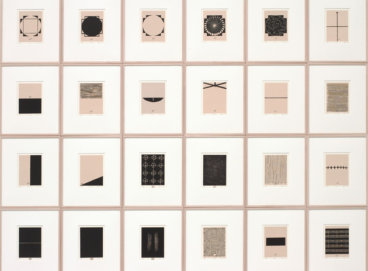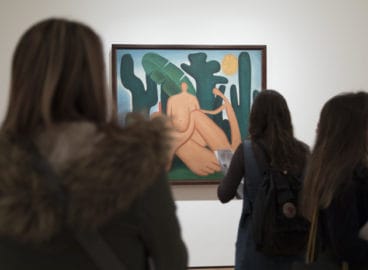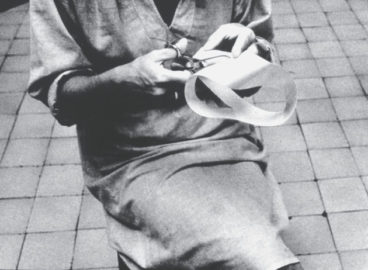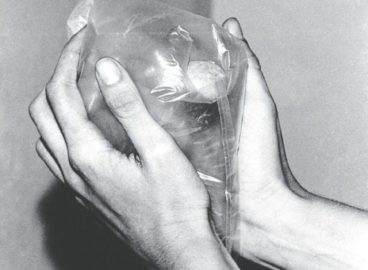Through Brazilian musician Caetano Veloso to ancient Roman philosopher Pliny the Elder, scholar Luis Pérez-Oramas outlines and contextualizes Brazilian artist Lygia Clark’s vast body of work. Part one of this essay examines Clark’s early works as form-based and the underlying performative aspects of their construction.
In addition to the essay by Pérez-Oramas, you can access installation views and the press release through MoMA’s online exhibition history archive here.
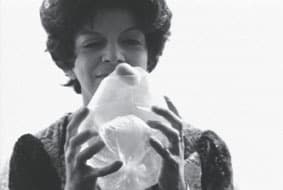
“Mondrian was a special case. Those red, blue, and yellow squares and rectangles seemed in reproduction as if they had been made with a ruler,” wrote the Brazilian musician Caetano Veloso in his autobiography,
and even when I asked myself, for that very reason, if they were a way forward or a dead end, I recognized those structures behind everything we called “modern”: buildings, furniture, clothing—and in the vibratoless notes of cool jazz and bossa nova. Lygia Clark’s bold investigations passed almost unnoticed: my friend Sônia Castro remarked one day in her studio that the total abandonment of painting as we knew it filled her with doubt. I clearly remember Sônia mentioning the word “stone” in her description of what she had seen of Lygia’s in a large group exhibition at the [Museu de Arte Moderna, Bahia], which I didn’t see, though I’m not sure why. It seems that Sônia herself—finishing an abstract painting that I found beautiful and that made her shed tears as she was painting it—was wondering if it was worthwhile to abandon oil paint, canvas, and brushes in order to participate in an exhibition with “a plastic sack full of water with a stone on top”. It’s odd that I should harbor this memory, since I don’t know what Lygia might have been exhibiting in Salvador in 1963–64. I think that Sônia’s phrase was a sort of exaggerated supposition, but it’s odd that what Lygia came to do (work to which I would pay homage in a song from 1971, “If You Hold a Stone”), should be so closely related to that description.1Caetano Veloso, Verdade tropical, 1997 (reprint ed. São Paulo: Companhia das Letras, 2012), p. 87.
Veloso’s brief recollection summarizes the trajectory that this essay will attempt to address. Our purpose here (and how could it be otherwise?) will be to see Lygia Clark in a way that is simultaneously progressive—as it attempts to move through her large and complex body of work—and regressive, since we will often construct our understanding by looking back toward the darkness of forgetting, toward zones now lost to oblivion, even though they were important in nourishing Clark’s thought. We will consider the genesis of work that may only realize itself in the future anterior tense, the future perfect, the “will have been”—as if embedded within it were its and painting’s own archaeology and archē, the Greek first principle.
A schematic idea of Clark’s art has become widely accepted. That understanding sets up her work as divided, as if she were two different artists: the first more conventional, concerned with form-based art, or “formalist” art, as some less critically involved with her work might say; the second abandoning form for an art of actions, relationships, and performative events, becoming one in the long story of modern artists who registered their dissidence in relation to aesthetics by abandoning art itself.
It is true that Clark abandoned art in her artwork. This deliberately contradictory sentence presents one of the challenges I will try to address: if her work continued to be art, if this essay appears in the catalogue of an exhibition of her work in an
art museum, if just four years before her death she helped to organize a retrospective of her work in an art museum, if her abandonment of art continued to manifest in her work in some way—if that abandonment is itself art—then the issue is in part that no matter how radically different her work may be from the phenomenon we usually call (or called) art, it remains part of art, even if in a negative way. Indeed it may be that Clark, in abandoning art in her artwork, allowed art to exist as a negative space within itself—that her work consisted in engineering art’s absence within art.

Clark was sensitive to the dilemma—the destiny—of separation: the separation between bodies, between beings and other beings, between mother and child, lover and beloved, between facts and their recollections, between present and past, living and dreaming, longing and having, lust and the failure to possess, from all of which arises the whole repertoire of ruptures, incisions, cuts, stitches, and other kinds of division within her work. Above all she was aware of those scissions’ most intense manifestation: what she called the “abyss” of the human body. All of her work seems to have been a way of looking directly at failure, the experience of which surrounds us in our lives’ activities, from the greatest to the most trivial. The interpretation of that work through a narrative of fracture between two aesthetic personas doesn’t seem to me to properly honor her endeavor, nor does it attend to the undertone, there from the beginning, of concern with a single focus: to work on the indices of separation. That reading may also correspond in too facile a way to the modernist impulse to understand artistic production in terms of simultaneous advance (as of an avant-garde) and abandonment of the past. And despite abundant evidence in both Clark’s work and her writing, it fails to recognize that she constantly asked questions about memory (ours, hers, everyone’s) and that her work responded to the experience of disjunction that produces our feelings of distance—in terms of both phylogeny and ontogeny—from what has constituted us since birth, from the site that must languish in oblivion yet at which we must have begun.
This essay, then, will attempt another reading of Clark, a reading based not on a narrative of a split in the work but on the ability to see forms within relational propositions—significant forms, forms with meaning, forms intended to have meaning. To this proposal, and in the face of the view of Clark’s work as irreconcilably divided, it is worth adding her own testimony, from around 1974:
My entire process has been an attempt to unite art and life, and sometimes when a raw perception comes to me in life, it is the abyss. The abyss—the thematic focus of my latest propositions and of my earlier ones as well. A couple sitting with their hands closed against one of their eyes which remains open, the other closed, the movement of their hands which open to allow a small space to form between them, the field of vision in the perception of the encounter of the spaces between the two people; this is how the space I call the interior space of the body is discovered….I experienced that space as an abyss until a short time ago. I began to wonder if that space might not be the same space that I’d been referring to for years as “empty-full,” a space that was still a metaphysical space….I discovered that in that space the body is the house, and that when people become conscious of that space, they rediscover the body as a totality—their vision of the world becomes broader….Let’s slow down, I didn’t say what I am;… I’d never a priori be a painter, a sculptor, or, much less, an architect. This is what surprises me every time I pose this problem to myself. Every time, I see with more clarity that my problem was purely existential in kind (space and time were my themes). If I began with painting, it was simply the point of departure that was most readily available.2Lygia Clark, typewritten note, c. 1974. Archives of the Associação Cultural “O Mundo de Lygia Clark,” Rio deJaneiro.
What is this space as abyss that Clark constantly indexed, in both her writing and her art? Is it perhaps a place, a coordinate, a moment, a memory? Or is it, rather, something indefinable, a phenomenon real but vast and inexhaustible, present in all people and especially between all people, a condition in which we are all similar and at the same time different, where we both resemble one another and are distinct from one another, where we are near yet distant, familiar yet foreign, estranged, strange? In 1960, when Clark wrote in the Rio newspaper Jornal do Brasil that she was addressing what she called the “vazio-pleno,” the “empty-full,” she defined the means of her investigation as “painting”—yet that investigation was for her “not optical, but rather was viscerally linked to the lived experience of feeling,” a profound feeling “whose origin cannot be located.”3Clark, “O vazio-pleno,” Jornal do Brasil (Rio de Janeiro), April 2, 1960, Suplemento Dominical, p. 5, Eng. trans. as “The Full-emptiness” in Lygia Clark, exh. cat. (Barcelona: Fundació Antoni Tàpies, 1998), a translation reprinted in the present volume, pp. 159–60, under the title “The Empty-Full.” If the empty-full was already that abyssal space, then Clark’s later work that was not painting, or was no longer painting, nevertheless derived from her painting, or shared a focus with her painting: the problem of existence itself, and that “new reality in which the work of art expresses itself as a living object, like you and me.”4Ibid., pp. 159–60.
It is at the very least odd to describe a work as a “living object” when in formal terms it looks cool, restrained, rational, measured, and dispassionate; yet Clark described her works programmatically in passionate writings full of ethical, erotic, and existential angst. So I’d like to propose a reading opposed to the conventional —in fact at this point canonical—understanding of Clark’s work as entailing a move from “paintings” to “things,” from the forms allowed by the conventions of the two- dimensional plane to a rediscovery first of objecthood, of the three-dimensional art object, and then of reality, of ordinary existence, of the body. Rather than an aesthetic reading of Clark’s neo-constructivist art, I propose an ethical one, as if, from the beginning of her production, she had seen geometric abstraction as a realm of filters or intellectual symptoms of problems that were ultimately existential, not to mention metaphysical. These problems first existed in her work as metonymic figures, or, better, as figural signatures—figures other than, more than, semiotic in character—that she would later unfold through real bodies, experiences, and propositions.5The ancient concept of the signature or “signature” has played a role in many epistemological fields within the Western tradition, from Thomas Aquinas’s thirteenth-century theology of sacraments, signs conceived of as healing, operative, and active, through the sixteenth- and seventeenth-century medical treatises of Paracelsus and Jakob de Boehme, in which natural things are analogically “signed” or “marked” (signatum) to reveal their invisible potentials, to the vast world of astrology, in which the designation of effective links between natural beings and constellations surpasses the notion of the sign. The idea of the signature is renewed in post- Structuralist thought, in the works of Michel Foucault and Jacques Derrida, through concepts such as “archaeology,” “architrace,” and “supplement.” In all of these historical iterations the signature appears as more than a simple sign, as the mark of a different realm of interpretation potentially contained within a given semiotic relationship. A “sign within a sign” (Enzo Melandri), the signature allows the passage from semiosis to hermeneusis, from meaning to interpretation. Signatures operate within the inevitable disproportion between semiology and hermeneutics. This implies, as Giorgio Agamben has suggested, that a theory of signification should be completed by a theory of signatures, which might resemble a theory of enunciation, as thinkers such as Foucault and Emile Benveniste have tried to define it. “Speech acts” are vestiges of language as signature, and sacraments are performed through speech acts. Sacramental signatures were conceived as healing signs and Clark herself conceived her art in terms of healing, beginning to set the object of that healing process, or goal, through nonobjective, nonrepresentational abstract geometric works. Those early works may be thought of as “figural signatures” of the issues that she would later on address more literally through her production at the end of her career. On the concept of the signature see Agamben, Signatura Rerum. Sur la méthode, 2008, Eng. trans. as The Signature of All Things: On Method, trans. Luca D’Isanto with Kevin Attel (Cambridge, Mass.: The MIT Press, 2009), chapter 2.

In 1998, the poet and philosopher Ferreira Gullar—earlier the author of theManifesto neoconcreto (Neo-concretist manifesto) of 1959—published a reading of Clark’s work that no one, in my view, has fundamentally challenged. It is the account of an artist who started out producing “abstractivized figurative painting” at the end of the 1940s, then embarked on an interrogation of the material conditions of the medium—flatness, surface, the plane, the frame—and finally “emancipated” painting from those limiting conventions, freeing it from its dependency on the wall and leading it to “fall.” I’d like to stress that word of Gullar’s: it falls, dropping from the wall to the floor like a a creature, a body, an organism.6Ferreira Gullar, “Lygia Clark’s Trajectory,” in Lygia Clark (Barcelona), p. 65.

Here is part of what Gullar has to say about Clark, and specifically about the emblematic series of sculptures called Bichos: “It becomes necessary to understand the pathway traveled by the artist before reaching this work which, because it is carried out in three-dimensional space, may be classified as a sculpture, but in fact derives, as we have seen, from painting. The surface of the painting, being emptied, denies the possibility of once again being the place where painting would be reborn, it grows, it opens onto the third dimension, it is disconnected from the wall and falls [my emphasis] onto the floor of the room to become an unusual and unexpected ‘Bicho.’”7Ibid. It grows, it opens, it disconnected from the wall, it falls: the words are significant in that they suggest a zoomorphic reading of these works, a reading that, it’s true, might seem legitimized by the series’s name: Bichos, critters. It’s also startling to notice that Gullar’s teleology of falling may owe a debt to the ghosts of other narratives, among them the Judeo- Christian idea of birth as a falling to earth. In any case, the narrative he proposes to explain how Clark’s work emancipated itself from painting (but also, implicitly, how Clark emancipated painting in turn) begins in 1952, with a series of abstract yet at the same time prismatically illusionistic works—works in which the possibility of identifying a set of spatial coordinates, a locus, within the visual structure matters more than the abstraction of the structure itself. It is as if Clark had sought, more than a form, an architecture that might imaginably be constructed in real space.
This investigation would lead Clark to a series of paintings whose planes appear physically distinct, clearly separated from each other. The surface is transformed into a topological field of reliefs and lines that are incised, not drawn—a field of folds and fissures, as in the Planos em superfícies moduladas (Planes on modulated surfaces) from 1956–58, or the Contra relevos (Counter reliefs) from around 1959. It is important to note here an earlier painting, Composição(Composition), from 1953, in which the lines dividing a structure’s splayed planes prefigure the forms of certain of the Bichos, anticipating the hinges that will allow them to be manipulated and folded. These lines in the painting are not graphic inscriptions but incisions in the density of the paint, bored into its material substance, excavated from the body of the plane: tangible intervals, cracks, crevices, hollows. This is the first step toward what Gullar describes as Clark’s painting disconnecting itself from the wall, a move he would see advancing in the works immediately following the Planos em superfícies moduladas and the Contra relevos: the Casulos (Cocoons). After the Casulos, in Gullar’s account, comes the “fall” of painting as “an unusual and unexpected Bicho.”
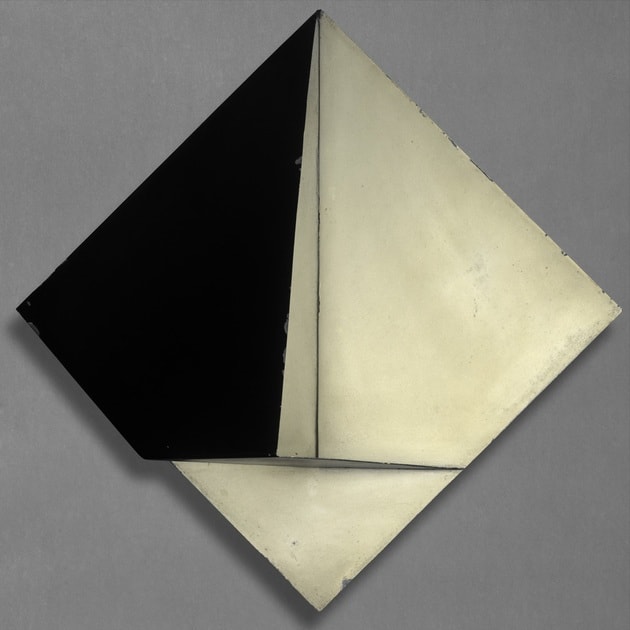

The correctness, the fairness, of this description is undeniable (if only the description were not, inevitably, also an interpretation). Equally undeniable the fact that although Clark would continue, until well into the 1980s, to produce versions of the constructivist-type works that she had conceived in the 1950s, her focus shifted, at least conceptually, from a repertoire of forms to a repertoire of propositions, actions, acts. The idea of the artwork as act is expressed unambiguously in her many reflections on Caminhando (Walking), of 1963, but it can be applied retrospectively as well as predictively, to her most formal paintings of the 1950s as well as to the relational actions of her late career. It is as if, in discovering the work as act and the act as work, Clark revealed the future anterior of an exploration located in her art from the beginning—in her brushes and cardstocks of the 1950s, and in the drawings and architectural sketches of the same period that marked the explicit onset of her existential, ethical, and “religious” investigations. “For me,” she wrote in 1960, “art is only valid in an ethico-religious sense, linked to the artist’s internal production in the deepest sense, that is, existentially.”8Clark, “The Empty-Full,” p. 159.
We must pause here, however, to take note of a phrase that Gullar uses at the start of his theory of painting’s fall to the ground in the form of the Bichos: “because it is carried out in three-dimensional space, [this work] may be classified as a sculpture, but in fact derives, as we have seen, from painting.” The issue for us is to clarify that derivation (or perhaps that dérive, or “drift”) as something other than a narrative of the emancipation of painting, for the narrative of “painting” becoming “object” is at this point a cliché in the narratives of modernism, and in the ideology of modernism as emancipation—as if the art of the past were a territory of limits and oppressions that modernism came in to liberate. Instead we might point to an origin that has nothing to do either with a specific moment, an instant in life or time, or with the work’s appearance as an organism, but rather with a legendary, foundational narrative of painting in the West.
Those who maintain that Clark “emancipated” painting by turning it into an object may be unaware that they are restating a very old myth. Pliny expressed this idea early on, in a section of his Naturalis Historia (Natural history, 77–79 a.d.) where he provides origin tales for the arts of antiquity. Contemporary readings of his text (which is more often cited than read) tend to take little account of the critical complexity already evident in the issue in ancient times: “The question as to the origin of the art of painting is uncertain,” in Pliny’s judgment, “and it does not belong to the plan of this work”—even though his work is devoted to just such origins as these. What follows this textual skirmish constitutes a much-debated topos in Western art discourse: “but all agree that it began with tracing an outline round a man’s shadow.”9Pliny the Elder, Natural History, 77–79 a.d., trans. Harris Rackham (Cambridge, Mass: Harvard University Press, 1952, reprint ed. 2003), XXXV, V, p. 271.
To bring out the meaning of this contradictory passage: the uncertainty of the origins of painting, the impossibility of knowing those origins, leads to the common belief or opinion—generalized, unfounded, and therefore purely a convention—that those origins consist in the drawing of the outline of a shadow. Something else here is also important, and all too often overlooked: Pliny’s earlier phrase “Primumque dicemus quae restant de picture,” “And first we shall say what remains of painting.”10Rackham translates this phrase, “And first we shall say what remains to be said about painting.” The original Latin, however, allows the literal reading, “And first we shall say what remains of painting.” That the point is “what remains of painting” is borne out by what follows in Pliny’s text—a description of painting as the “illustrious art of yore…today completely supplanted by marble and gold.” This implies, first, that a discourse on painting is a discourse on what remains of painting, since painting is an art of the past; and second, that it is a discourse on what still remains to be said about painting, constituting a substitutive dimension of painting, a supplementary effect, a supplement in the contemporary sense of the term. See ibid., XXXV, I, p. 261. Not only are the origins of painting uncertain, then, but painting itself, at the moment of this formative recounting of its origins, is an art that has died. It is an art about which there is never anything to say—or always nothing to say—but what remains of it.
If we are to oppose an idea of continuity to the ultimately simplistic account of Clark’s work as disjunctive—in other words, if we are to move beyond a narrative of painting falling unexpectedly to the floor in order to liberate itself from the wall, which had been oppressively maintaining it in a primitive state—we must understand this dimension of the discourse on painting as words that always come late, expressing only what remains of an art whose origins (at least to the extent that they are recorded in writing, and at least by Pliny) are determined by its present inactuality.
Pliny, then, reveals the origin of painting only once everything else he has found to say about that art he has already said. And what he says was the first painting of all —a work of love and anticipated longing, made in the face of an imminent separation—is in his story immediately supplemented by a body of clay, which gives a trace of a shadow a material presence, a distension, a self-impregnation. The painting itself is simply the outline of a shadow, a form that Marcel Duchamp might have called “inframince,” or “ultra-thin,”11See Marcel Duchamp, Duchamp du signe. Ecrits (Paris: Editions Flammarion, 1994), p. 274. but this incorporeal presence expands, is inflamed, gains volume, receives a new body, a supplementary solidity, and thus becomes a different form of art, an art no longer dependent on the wall that supports it.

The idea of the body of painting as something inflamed into becoming a “thing”—a “thing” that for Gullar is “unusual and unexpected,” though the idea dates back to Pliny—we of course have seen applied to Clark’s progress between 1948 and 1960, from her earliest images of stairs to her Abrigos poéticos (Poetic shelters). Yet it seems to me that no matter how well this account might describe a formal evolution, it ignores or fails to recognize an essential aspect of Clark’s trajectory, an unconsidered fragment of reality: the fact that for her the issue was not a matter of moving from one art to another but of lingering inside a problem, within painting and from there affecting art as a whole, for she would ultimately question the entire practice of art as a means of self-expression through the production of objects. This is why, within the formal territory of abstraction as Clark handled it, I want to identify the ghostly anticipations of her later production: the possibilities of an art in terms of its own powers of negativity, an “infra-art,” perhaps, or what Clark herself called “the singular state of art without art.”12Clark, “1965: A propósito da magia do objeto.” Archives of the Associação Cultural “O Mundo de Lygia Clark.”
This is the first section of a three-part essay by Luis Pérez-Oramas on the Brazilian artist Lygia Clark, excerpted from the exhibition catalog Lygia Clark: The Abandonment Of Art, 1948-1988, available at the MoMA bookstore. Read the second section here and the third here.
- 1Caetano Veloso, Verdade tropical, 1997 (reprint ed. São Paulo: Companhia das Letras, 2012), p. 87.
- 2Lygia Clark, typewritten note, c. 1974. Archives of the Associação Cultural “O Mundo de Lygia Clark,” Rio deJaneiro.
- 3Clark, “O vazio-pleno,” Jornal do Brasil (Rio de Janeiro), April 2, 1960, Suplemento Dominical, p. 5, Eng. trans. as “The Full-emptiness” in Lygia Clark, exh. cat. (Barcelona: Fundació Antoni Tàpies, 1998), a translation reprinted in the present volume, pp. 159–60, under the title “The Empty-Full.”
- 4Ibid., pp. 159–60.
- 5The ancient concept of the signature or “signature” has played a role in many epistemological fields within the Western tradition, from Thomas Aquinas’s thirteenth-century theology of sacraments, signs conceived of as healing, operative, and active, through the sixteenth- and seventeenth-century medical treatises of Paracelsus and Jakob de Boehme, in which natural things are analogically “signed” or “marked” (signatum) to reveal their invisible potentials, to the vast world of astrology, in which the designation of effective links between natural beings and constellations surpasses the notion of the sign. The idea of the signature is renewed in post- Structuralist thought, in the works of Michel Foucault and Jacques Derrida, through concepts such as “archaeology,” “architrace,” and “supplement.” In all of these historical iterations the signature appears as more than a simple sign, as the mark of a different realm of interpretation potentially contained within a given semiotic relationship. A “sign within a sign” (Enzo Melandri), the signature allows the passage from semiosis to hermeneusis, from meaning to interpretation. Signatures operate within the inevitable disproportion between semiology and hermeneutics. This implies, as Giorgio Agamben has suggested, that a theory of signification should be completed by a theory of signatures, which might resemble a theory of enunciation, as thinkers such as Foucault and Emile Benveniste have tried to define it. “Speech acts” are vestiges of language as signature, and sacraments are performed through speech acts. Sacramental signatures were conceived as healing signs and Clark herself conceived her art in terms of healing, beginning to set the object of that healing process, or goal, through nonobjective, nonrepresentational abstract geometric works. Those early works may be thought of as “figural signatures” of the issues that she would later on address more literally through her production at the end of her career. On the concept of the signature see Agamben, Signatura Rerum. Sur la méthode, 2008, Eng. trans. as The Signature of All Things: On Method, trans. Luca D’Isanto with Kevin Attel (Cambridge, Mass.: The MIT Press, 2009), chapter 2.
- 6Ferreira Gullar, “Lygia Clark’s Trajectory,” in Lygia Clark (Barcelona), p. 65.
- 7Ibid.
- 8Clark, “The Empty-Full,” p. 159.
- 9Pliny the Elder, Natural History, 77–79 a.d., trans. Harris Rackham (Cambridge, Mass: Harvard University Press, 1952, reprint ed. 2003), XXXV, V, p. 271.
- 10Rackham translates this phrase, “And first we shall say what remains to be said about painting.” The original Latin, however, allows the literal reading, “And first we shall say what remains of painting.” That the point is “what remains of painting” is borne out by what follows in Pliny’s text—a description of painting as the “illustrious art of yore…today completely supplanted by marble and gold.” This implies, first, that a discourse on painting is a discourse on what remains of painting, since painting is an art of the past; and second, that it is a discourse on what still remains to be said about painting, constituting a substitutive dimension of painting, a supplementary effect, a supplement in the contemporary sense of the term. See ibid., XXXV, I, p. 261.
- 11See Marcel Duchamp, Duchamp du signe. Ecrits (Paris: Editions Flammarion, 1994), p. 274.
- 12Clark, “1965: A propósito da magia do objeto.” Archives of the Associação Cultural “O Mundo de Lygia Clark.”
